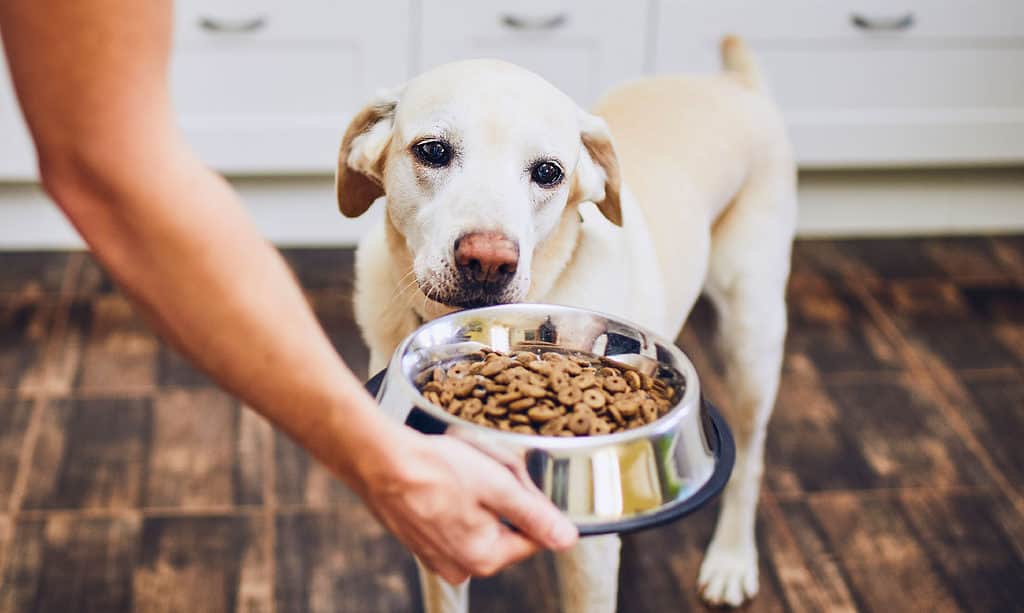Despite being one of the most popular dog breeds, Labrador Retrievers aren’t for everyone. In the wrong household, they can be destructive, loud, and unpleasant to live with. Even people who are in love with their dogs sometimes have complaints about Labradors.
The main complaints about Labradors are that they’re energetic, large, expensive, clingy, mouthy, and shed heavily. They’re also prone to a variety of health problems that can be sad and expensive to deal with.
In this article, we’ll talk about the popularity of Labradors, their pros and cons, and 22 reasons that they can be troublesome to live with. These are all coming from a former Lab owner, so rest assured that everything in this article was written with love!
Why are Labradors so Popular?

Labradors are beloved for their sweet, outgoing personalities.
©melissamn/Shutterstock.com
Before getting into common complaints about Labs, you should know that Labradors are one of the most popular dog breeds in the United States, and this is for good reason!
They’re friendly, affectionate, and make great family dogs. When trained properly, Labs are great with kids and other pets (though dogs and children should never be left unattended).
They love to be involved in group activities and don’t tend to be single-person dogs, so no family member will feel left out around them. This isn’t true for all dog breeds, as many will choose a favorite person and cling to their side!
Labradors are great for those with little dog experience because they’re biddable, smart, and easy to train.
For all of their positive attributes, there are some objectively negative things about Labradors, such as their high risk of developing certain health problems. Depending on your lifestyle and preferences, you might also see some of the traits above as cons.
It’s important to acknowledge the good and the bad before adopting a dog, so let’s delve into some disadvantages of owning the breed.
Common Complaints about Labradors
#1: Labradors Need a Lot of Exercise

Labradors need long daily walks and plenty of play.
©iStock.com/gorodenkoff
Couch potatoes won’t enjoy having an energetic Labrador in the home–unless you’re looking for an exercise companion to help change your lifestyle.
Labradors need hours of daily exercise. Without this, they can easily become overweight, leading to health problems.
Your Labrador will also become bored and is likely to seek their own entertainment, which commonly means barking at everything they see or destroying household items.
These behaviors are easily one of the top complaints people have about their Labs.
#2: Labs stay “Young” Longer than Other Breeds
In addition, Labradors don’t tend to lose their puppy energy until they’re at least a few years old. Learning to settle is an essential skill to teach your Labrador, but it’s also important that they get plenty of activity throughout the day.
My own Labrador went for two-mile walks well into old age, even after a cancer diagnosis that the vet had expected would slow him down considerably. Because Labradors are prone to joint issues, this won’t be the case for all of them–but it’s good to be prepared for the possibility.
While this is a con for some, others will love the lighthearted fun that comes from caring for a Labrador. They definitely keep you active and on your toes, especially during the first few years.
#3: They Need Lots of Mental Stimulation

Training can keep your Lab’s mind engaged and keep them from becoming bored.
©iStock.com/chris-mueller
Alongside physical exercise, it’s also important that Labradors’ bright minds are engaged. This can be done alongside physical activities through games of fetch, or you can use activities like nose work games or puzzle toys to keep your dog occupied.
Training is another great way to keep your dog engaged, and there are so many things that these smart pups can learn!
#4: They were Bred to Hunt
Individual prey drive varies, but most Labs will be interested in small prey–especially waterfowl such as ducks or geese. Even those without a strong hunting drive will show curiosity and might get themselves bitten or chased by an aggressive bird!
It’s also very possible that your Labrador will chase birds and other animals if allowed off-leash, especially in the water. You might find a few “presents” in the form of dead prey in the backyard as well.
Unlike some hunting breeds, however, Labradors tend to do well with smaller mammals such as cats or small dogs. Their hunting instincts also make them great at games like fetch, and their love for the water makes them the perfect summer companions.
#5: Labradors are Heavy
Healthy Labradors weigh 55-80 pounds. Some are naturally larger than this, especially mixed breeds, and overfed Labs can weigh even more.
Food and medications cost more for heavier dogs. They’re also difficult to control when pulling on a leash, and might be impossible for you to lift in an emergency. Labs who think they’re lap dogs can squish you when trying to snuggle on the couch.
However, it’s not all bad. Large dogs are intimidating to those with ill intentions, such as burglars. Since Labs are also tall, you don’t have to bend to pet them, and they make great snuggle buddies–you just might need to teach them not to lie directly on your chest!
#5: They Shed Heavily

Labradors shed a lot, especially during shedding season.
©iStock.com/Oskari Porkka
Labradors don’t shed in clumps like you see in super high-shedding breeds, such as Akitas or Samoyeds. However, they will cover your floors, your furniture, and your clothes with hair! Many Lab owners complain about having so much fur around the house.
The most common Labrador colors are black and yellow, which both tend to stand out on surfaces. This makes fur easier to see and clean, but guests will notice if it’s been a while since you last vacuumed.
It’s common for Labrador fur to gather in corners, especially on hard flooring. You’ll want to brush them at least once a week to maintain good coat health and reduce the fur you find around your home.
#6: Labs Tend to be Clingy
Some dogs are like a shadow, following you around. Labradors tend to be these dogs, and it’s important to include them in your activities, whether it’s lying at your feet while you answer emails or joining you outside while you garden.
If you treasure your personal space, a Labrador probably isn’t for you. Most of them like to stay close!
On the other hand, many people love this about their sweet Labradors.
#7: They’re Prone to Separation Anxiety

Labs can get anxious when left home alone.
©Jaromir Chalabala/Shutterstock.com
Separation anxiety can be a pain to deal with, so it’s no surprise that it’s a top complaint about Labradors! It’s important that these pups learn from a young age that being alone is safe, and that their people will always return home.
It’s also vital not to push them past their limits. Labradors aren’t dogs who can be left alone all day, and those who’ve already developed separation anxiety will need even more attention.
Labs who don’t get their needs met, including their social needs, will turn to problematic behaviors such as excessive barking or destructive chewing.
#8: They do Best with Families
Taking the above into consideration, Labradors do best when they live with families where someone is usually home. Single people who work outside of the home should rethink adopting a Lab unless they can hire a dog sitter or dog walker to come to the house around the middle of the work day.
#9: Labs Chew…A Lot!

Labradors are strong chewers who tend to be quite mouthy.
©MaxShutter/Shutterstock.com
Labrador puppies can be a challenge to handle because they seem to want to chew everything in sight. Make sure to put away your favorite pair of shoes and to keep dangerous items, like cleaners and poisonous plants, well out of reach.
Even adult dogs can be destructive if they don’t get enough exercise, which can lead to boredom and misbehavior. Dogs with separation anxiety are also prone to chewing to relieve that stress.
Remember that your Labrador will never chew your things out of spite or anger–it’s typically due to a lack of training, teething, or a stress response.
#10: They’re Mouthy, Especially as Puppies
Labrador puppies are also prone to nipping and mouthing at people. It’s important to remember that this is normal puppy behavior, but also not to allow it to continue into adulthood.
Redirect your puppy’s teething and playful bites to chew toys. Provide a variety of sizes and textures so they can choose what works best for them.
If your pup is overexcited and won’t stop biting, remove yourself for a few minutes, then return and give them another chance to play calmly. This teaches them that when biting starts, playtime ends.
Because Labrador puppies are large and their nips can hurt, you may need a way to separate them from children in the household until they learn better bite inhibition. Supervised interactions while the puppy and child are both calm work best at this stage.
#11: They’ll Eat Anything

It’s far too easy to overfeed a Lab!
©iStock.com/Chalabala
Labradors are prone to overeating, which is why many Labs are overweight. Their puppy dog eyes don’t help with keeping them on a diet, either!
Unfortunately, most people don’t know what a healthy Labrador weight looks like. Talk to your veterinarian about how much your Labrador should eat, and ask what they think of their current weight.
Another problem with Labradors is that they’ll eat things that aren’t food. Even when the house is puppy-proofed, your dog might get into something unexpected, or that you only turned your back on for a moment!
Surgery for intestinal blockages is expensive, so it’s important to watch your Lab carefully, puppy-proof your home, and consider a puppy-proofed room, playpen, or crate for when you’re away.
While it might not seem like there are any pros to this behavior, you can be assured that your Lab won’t be a picky eater! Whatever dog food you choose, they’re likely to gobble it right up.
Their food-motivated natures also make them easy to train.
#12: They’ll Outsmart You!
Labradors are very intelligent. It’s not uncommon for them to convince someone else in the household to feed them after you’ve just given them their dinner, for instance. They can learn to open doors and may bend the rules when learning new tricks.
For example, they might scoot forward when asked to sit and stay or walk a few paces when asked to “crawl” before laying back down as a bit of a cheat. Their antics are so funny that it can be difficult not to laugh and reward the behavior!
#13: Labradors are too Friendly to Guard

Labradors tend to be incredibly friendly, and may not make good guard dogs.
©Rosa Jay/Shutterstock.com
Some Labradors make good guard dogs, and many will protect their own when it comes down to it. But, you likely won’t want to depend on this.
The truth is, most Labs see everyone as a potential friend. They make good watchdogs who will bark when they see something unusual, but guarding isn’t their specialty.
That said, they’re imposing and will scare away most would-be intruders before you have the chance to see how they’d actually react to a break-in. This is especially true for black Labs, who many people perceive to be scarier than yellow Labs.
#14: They’re Incredibly Outgoing
If you’re an introvert, you might not love the outgoing nature of a Labrador. They tend to make friends everywhere they go, and it doesn’t help that Labs are one of the most popular dog breeds in the United States. Not only do Labs love people, but people love them right back!
That said, you might enjoy making friends with other dog lovers on your walks. Or, you could opt for a black Labrador to keep some people back–as we discussed above, many people find them scary!
#15: They Can be Smelly
Labradors can definitely smell like dogs–and often like wet dogs, because they love to swim. Their water-resistant coats can trap odors, and they often become dirty on their outdoor adventures.
Brushing your dog frequently helps to distribute their natural oils across their skin and coat, which can reduce their smell. It also removes shed fur that can hold onto odors.
Baths, especially after your dog has been in the water or traipsing through the mud, will also remove some of that stink. I’ve always liked oatmeal dog shampoos because they’re gentle on the skin.
If you’re bathing your Lab often, you might also want to invest in some dog conditioner so their skin and coat don’t become too dry.
Another alternative is to use dry shampoo in between baths to keep odors at bay.
#16: They’re Expensive

Before adopting a Lab, make sure you can afford their care.
©SeventyFour/Shutterstock.com
Labradors aren’t cheap dogs. They should be fed quality dog food made for large, active breeds. While it’s important not to overfeed them, you’ll still need to buy more than you would for a smaller breed, like a Beagle or Chihuahua.
Labs are also prone to expensive accidents and health problems. Many of them will eat everything in sight, which can cause intestinal blockages that require surgery to remove. Hip dysplasia, gastric dilatation-volvulus (GDV), and cancer are a few common health problems that can be costly.
#17: Many Labs have Recurring Ear Infections
Labradors are prone to allergies and love the water, both of which can lead to ear infections. Most Lab owners will quickly learn to spot an ear infection in their dogs since they’re so common.
You can help your Labrador by eliminating allergens when possible, though this can be impossible with some environmental allergies.
Wiping their ears dry after a swim and keeping water out of their ears when possible are other ways to prevent ear infections from occurring. It’s also important to get to the vet quickly after noticing an infection, as prompt treatment will stop the infection from spreading to the inner ear and other areas of the body.
#18: Labs are at High Risk of Developing Joint Problems
Labradors are large dogs who have a tendency to become overweight. Both of these factors contribute to joint problems including hip and elbow dysplasia, CCL injuries, and arthritis.
Keeping your Labrador at a healthy weight reduces their chances of developing joint issues. A study by Purina showed that, even when it didn’t completely eliminate health risks, Labs at healthy weights developed health problems later in life than overweight Labs. They also tend to live nearly two years longer.
#19: They’re also Prone to Fatty Tumors
Fatty tumors, also known as Lipomas, are lumps that grow right beneath the skin. They typically aren’t cancerous but can turn into cancer on rare occasions.
Overweight Labs and those with thyroid disease are most likely to develop fatty tumors, but they can occur in healthy Labradors as well.
#20: Labradors are Prone to Cancer
Cancer is a leading cause of death in all dogs, but Labs are very prone when compared to other breeds. They’re especially prone to Lymphoma.
This is one of the top complaints about Labs since it’s so sad to experience, but it can happen in any other breed as well. So, I wouldn’t say it’s a reason not to adopt, just something to be aware of.
#21: Labs have Higher Rates of Bloat
As large, deep-chested dogs, Labradors are prone to a condition called bloat. Unlike human bloat, bloat in dogs is often deadly.
Also known as gastric dilatation-volvulus, or GDV, bloat happens when a dog’s stomach fills with air, swells, and flips inside of the body. This blocks blood flow to other vital organs.
Because bloat can quickly kill a dog, it’s important to know the signs and how to prevent it. Symptoms of bloat include a swollen, painful abdomen, retching, excessive drooling, restlessness, and a “downward dog” pose with the hind end in the air and the head pressed to the floor.
Ways to avoid bloat include avoiding raised food bowls, utilizing slow feeders, not hydrating your dog’s kibble, and keeping stress low around mealtimes. This includes not exercising your Lab directly before or after a big meal or drink.
#22: Exercise-Induced Collapse is Sometimes Seen in Young Dogs
This condition causes random collapse while exercising, in seemingly healthy young dogs. It typically passes within a few minutes, but limits a Lab’s ability to exercise, especially in the heat.
It can also make them more prone to heat stroke.
Luckily, there are genetic health tests for EIC, and reputable breeders will screen for the condition before breeding.
Thank you for reading! If you have feedback on this post, please contact the AZ Animals editorial team.
The photo featured at the top of this post is © 4 PM production/Shutterstock.com
Ready to discover the top 10 cutest dog breeds in the entire world?
How about the fastest dogs, the largest dogs and those that are -- quite frankly -- just the kindest dogs on the planet? Each day, AZ Animals sends out lists just like this to our thousands of email subscribers. And the best part? It's FREE. Join today by entering your email below.
Thank you for reading! Have some feedback for us? Contact the AZ Animals editorial team.







